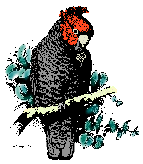 |
canberrabirds
|
 |
canberrabirds
|
| To: | "" <> |
|---|---|
| Subject: | FW: FW: A colossal achievement: from the June newsletter of BirdLife International |
| From: | "calyptorhynchus via Canberrabirds " <> |
| Date: | Mon, 30 Jun 2025 23:17:38 +0000 |
|
I dunno, a rose by any other name would smell as sweet. I don't think I even think of birds by their official names until I have to write them down or talk about them to other birdwatchers. I go around thinking 'Stilt' or 'grey-and-white Kite'
and I have to pause to think 'it's White-headed Stilt and Black-shouldered Kite'. These are no more logical than calling them, say, Australian Stilt and [C19 notable's name]'s Kite.
I don't think a new agreed list of common names is going to make any difference to my birdwatching.
John L
On Mon, 30 Jun 2025 at 19:12, Wallaces via Canberrabirds <> wrote:
Confidential communication - This email and any files transmitted with it are confidential and are intended solely for the addressee. If you are not the intended recipient, please be advised that you have received this email in error and that any use, dissemination, forwarding, printing, or copying of this email and any file attachments is strictly prohibited. If you have received this email in error, please notify me immediately by return email and destroy this email.
|
| <Prev in Thread] | Current Thread | [Next in Thread> |
|---|---|---|
| ||
| Previous by Date: | FW: FW: FW: A colossal achievement: from the June newsletter of BirdLife International, Geoffrey Dabb via Canberrabirds [canberrabirds-bounces@lists.canberrabirds.org.au] |
|---|---|
| Next by Date: | Choughs under Siege, Brian via Canberrabirds [canberrabirds-bounces@lists.canberrabirds.org.au] |
| Previous by Thread: | FW: FW: FW: A colossal achievement: from the June newsletter of BirdLife International, Geoffrey Dabb via Canberrabirds [canberrabirds-bounces@lists.canberrabirds.org.au] |
| Next by Thread: | A colossal achievement: from the June newsletter of BirdLife International, Steve Read via Canberrabirds [canberrabirds-bounces@lists.canberrabirds.org.au] |
| Indexes: | [Date] [Thread] [Top] [All Lists] |
The University of NSW School of Computer and Engineering takes no responsibility for the contents of this archive. It is purely a compilation of material sent by many people to the Canberra Ornithologists Group mailing list. It has not been checked for accuracy nor its content verified in any way. If you wish to get material removed from the archive or have other queries about the list contact David McDonald, list manager, phone (02) 6231 8904 or email . If you can not contact David McDonald e-mail Andrew Taylor at this address: andrewt@cse.unsw.EDU.AU